Is it better to be active or static? To change your location and composition to suit the light, or hope that the light changes to suit your composition?
There’s this persistent myth that Ansel Adams would camp for days at one spot, waiting for the right light. Ironically, this myth is often repeated in relation to Clearing Winter Storm, which was made at Tunnel View, only a few miles from his warm home and comfortable bed in Yosemite Valley. In fact Ansel wrote, “I have always been mindful of Edward Weston’s remark, ‘If I wait for something here I may lose something better over there.’ I have found that keeping on the move is generally more rewarding.”
I have also found that keeping on the move is more rewarding. I’ve sometimes regretted moving, but more often regretted staying when I ignored the inner voice that told me the light would be better elsewhere. And when I do find myself in the right place at the right time, I’ve found that it pays to stay active with my camera and my compositions, and not get lazy about changing lenses or camera positions. If I decide in advance what my composition should be, and stick with that no matter what, I’ll probably miss some great opportunities.
The sunset on Half Dome that I described in my last post is a good example. The light show lasted for about 45 minutes, and during that time I was constantly reassessing the scene and re-framing my composition to showcase the light and clouds at that particular moment. Sometimes I even moved left or right along the riverbank to change the relationship between the foreground and background.
I made the photograph at the top of this post at 4:28 p.m. At that moment the sun was illuminating Half Dome and North Dome, and some of the trees near the river were beautifully silhouetted against the sunlit cliff underneath North Dome, so I made sure my composition included all those areas, plus some of the clouds above and reflections below.
By 4:42 p.m. the sun had reached the top of Half Dome, so it seemed like a good time to zoom in a bit and include just Half Dome and its reflection. I moved left along the riverbank to line up the most colorful cottonwood trees with Half Dome, and get the foreground trees to the right of Half Dome out of the frame:
As I was taking that previous photograph, I could see that the light had returned to North Dome on the left. But from where I was then standing, North Dome was partially obscured by trees, so I scurried back to the previous spot, and framed another composition similar to the first one, except that I included some leaves along the shore in the foreground. This exposure was made one minute later, at 4:43 p.m. (this is the image from the previous post):
By 4:49 an interesting bank of clouds had appeared to the right of Half Dome, so I tipped the camera over into a horizontal orientation to include that cloud:
Two minutes later, with the most intense color yet on Half Dome and North Dome, I switched back to a vertical orientation:
Two minutes after that, at 4:53, I zoomed out a bit to include more of the colorful cloud to the right of Half Dome:
And at 4:56 p.m., just before the color started to fade, the moon popped out from behind the clouds, so I pointed the camera more to the right to include the moon and its reflection:
For more examples, in this post from last year I included six images from Tunnel View, made over the course of two evenings, all with different compositions.
A look at Ansel Adams’ contact sheet for Moon and Half Dome reveals that he varied his compositions, and exposures, and even turned his camera toward other subjects. If, as Ansel said, “Chance favors the prepared mind,” part of that mental preparation includes the flexibility to take advantage of special moments, and to adapt your composition to the light.
— Michael Frye
P.S. What’s been your experience—have you had better luck being active or static when the light is changing? And also, do you have a favorite from this set of images? If so, let me know.
Related Posts: Courting Luck: How to Take Advantage of Special Light and Weather in Landscape Photography; Storms at Last! Six Images From Tunnel View; Redwoods, Fog, and Serendipity; Embracing Uncertainty
Did you like this article? Click here to subscribe to this blog and get every new post delivered right to your inbox!
Michael Frye is a professional photographer specializing in landscapes and nature. He is the author or principal photographer of The Photographer’s Guide to Yosemite, Yosemite Meditations, Yosemite Meditations for Women, and Digital Landscape Photography: In the Footsteps of Ansel Adams and the Great Masters. He has also written three eBooks: Light & Land: Landscapes in the Digital Darkroom, Exposure for Outdoor Photography, and Landscapes in Lightroom 5: The Essential Step-by-Step Guide. Michael written numerous magazine articles on the art and technique of photography, and his images have been published in over thirty countries around the world. Michael has lived either in or near Yosemite National Park since 1983, currently residing just outside the park in Mariposa, California.

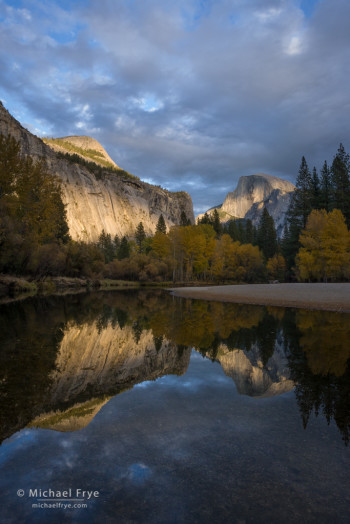
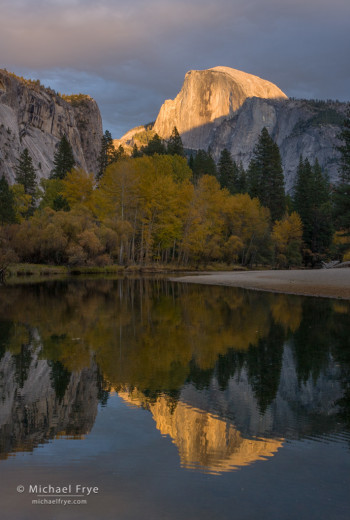
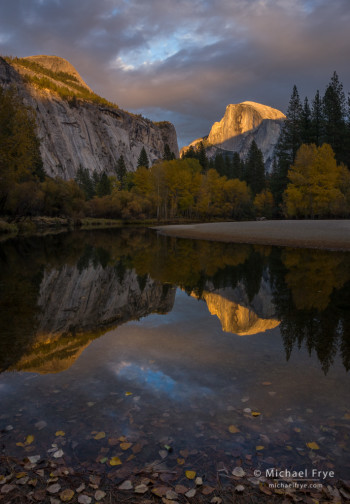
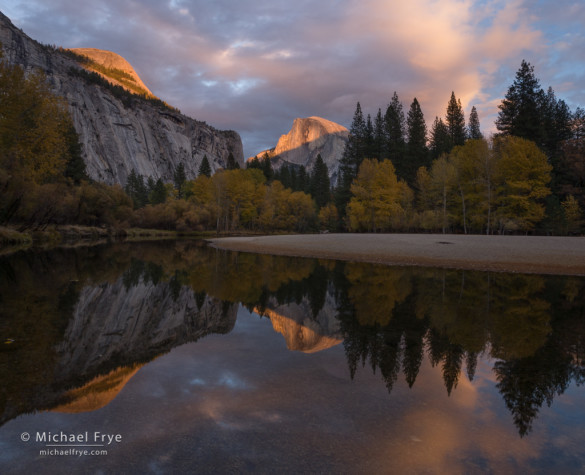
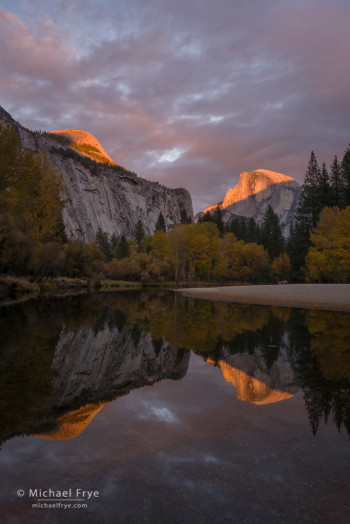
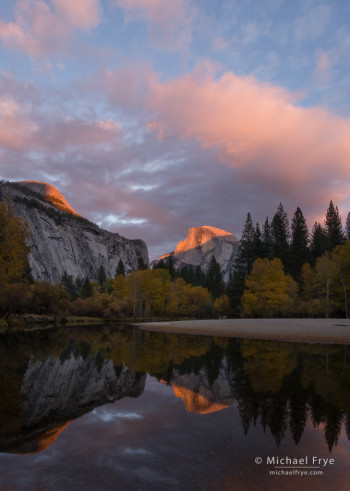
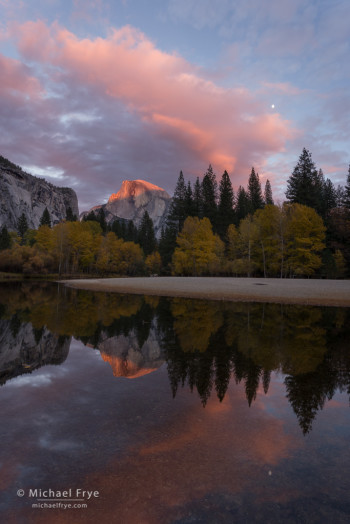








Thank you for posting this whole series from that evening. It is very illuminating 🙂 to see how the light changed through the sunset and your thought process to try to capture it. My vote would be for 4:51 mostly because I think it is the most dramatic light. I do kind of miss the leaves from the 4:43 shot but that’s how things go sometimes.
I’d say I have better luck being active, if for no other reason than because I get too antsy to actually stay static!
You’re welcome Kyle, and thanks! I like the one from 4:51 too for the same reason. In that moment I thought the light was dramatic enough to stand on its own, and that including the leaves would just be a distraction. But maybe not. We’ll never know because I didn’t try it; maybe I should have!
If you have better luck being active, great. Sometimes, though, waiting is the best strategy. These decisions are often difficult!
Interesting watching the light change so quickly and the compositions you made with them. My vote is for 4:42 and 4:43. I like the light and reflection almost framing the trees. I like 4:43 because of the leaves up front. It leads me into the image more then the others do.
I’m definitely more static since I can sit for hours waiting for wildlife. I’m trying to improve my landscapes so I guess I need to start moving more.
Nancy, patience is a virtue in landscape photography as well as with wildlife, but it all depends. In any situation you have to evaluate, using whatever information you can get, where the best photographic potential lies. Sometimes that means waiting, sometimes that means moving.
They are all beautiful Michael, but I prefer the first one best followed closely by the third one. The light on both domes and the cliff is just perfect. Add in the clouds and the symmetry of the reflection and it only makes it even better. Were those taken anywhere near Cathedral Beach?
I’ve been of the belief you have to keep moving because like with most things in life, success doesn’t come looking for you, you have to work to find it.
Thanks very much John! No these were not made near Cathedral Beach, as you can’t see Half Dome from there. This spot is in the eastern end of Yosemite Valley; I describe it in the Sentinel Bridge entry of my Photographer’s Guide to Yosemite book and app.
Thanks Michael. I’ve got the app so I’ll have to check it out. I’m hoping to make a winter trip there once some snow falls.
Fantastic set, and great dialogue to go with. I’ve always been a ‘grass is greener’ kinda gal, so I am always on the move….just ask my friends whom I often go on photo safaris with…they often ‘lose’ me, because I never stay in the same spot or position! I’ve had great success with this method, and love moving around and composing new shots and changing out my lenses…okay, I don’t love to change my lenses, but I do it! I had a sunset shoot recently at Mono Lake that went on for quite awhile, and had I stayed put I would have missed so much…all around in a 360 arc were shots to be had of different clouds, tufa formations, mtn. views, light and color. Plus, I think it’s fun to see the different views we all find and come up with at the end of the day, in our ‘review’ sessions, over a nice glass of wine!
Thanks Susan! Glad to hear that you’ve had success in moving around. And yes, it’s always fun to see how different people photograph the same place!
My preference would be the, to my eye, more dynamic landscape orientation. It really draws me in and then holds me there.
Thanks for chiming in Jerry!
…on another note… the contact sheet of Moon Over Half Dome from Corbis Images is quite edifying. I wish I could have a copy to pin to my wall over my workstation, but alas… a grand or more is a little steep…! -:o)
Yeah, I really enjoyed seeing that contact sheet as well. I didn’t price it out. 🙂
Michael,
thanks for the great blog on this very relevant topic. I know every photographer will be faced with this tough decision sooner or later. I usually try to stay adaptive to what conditions are present when I get to a site, even if I have previsualized a particular image scene. I recently went to the First Manassas National Battlefield with the goal of photographing a series of pictures with the moon rising behind the large statue of Stonewall Jackson, and starting with some early blue hour images to capture foreground detail for later exposure blending. I used The Photographer’s Ephemeris to pick the day when the full moon would rise behind the statue during the late blue hour light, and to pick my exact location. Of course, this technique would require keeping the camera on the tripod and in place for the whole session. Well into my process, over my shoulder to the west, the most glorious sunset I seen in ages in going on in the opposite direction. It was still a few minutes before the moon actually popped up over the horizon behind old Stonewall, so I was mightly tempted to drop my earlier effort and try to capture that sunset scene and then try to switch back to the original plan. As this is going on, my inner voice is screaming that you are missing the rare gift that Mother Nature is bestowing on you. I still have not gone back to process and blend my moonrise series, but I have high hopes for some great images out of the effort. But I will always remember the mental struggle that accompanied that effort and wonder what could have been…my lesson learned, bring at least two dslrs to a session like that so you can be adaptive and also execute your earlier vision.
You’re welcome John, and thanks for sharing your story about the moonrise photos. I think most of us have experienced similar conflicts at one time or another, and there are no easy answers or simple formulas for making these decisions. In your case, you couldn’t move the camera without ruining your planned sequence, so that made it even harder. But after-the-fact rationalization always works in these situations, like, “It was a nice sunset, but it would have been just another nice sunset photo.” 🙂
Michael,
thanks for the reply. Started working on the moonrise series, trying to make a composite image of the moon as it rose from the horizon on the left of the statue to when it was above the statue in the upper right hand corner of the frame. Working through some challenges of blending the layers and masks between the shots to get the sky to transition from faint pink at the bottom to a very dark blue at the top, but a pretty cool composition if I can get it to work. So maybe it will be worth missing the sunset after all… : )
Great results, Michael. Thanks for allowing the readers to get inside your head to know what you were thinking and why you did what you did at the time. We often find ourselves asking all these same questions when faced with changing light. It’s a real challenge to avoid missing some opportunities that are often right in front of our faces.
Thanks Tim, and yes, these situations can definitely be challenging!
great post as usual. That contact sheet is really helpful. And the images are gorgeous and so much learning .
rgds
Thanks Dinesh, and I’m glad you enjoyed seeing the contact sheet — I did too.
All of the images are great Michael. Excellent examples of moving around the scene to gain different compositions. This is something I practice but yet to master as I still come home with more shots than I need of the same image / composition. Sometimes I am just a prisoner of hope… hoping the light changes that little bit to give me the image I want. I would have to say 4:43 would be my favorite as the sky and the light on both domes works well together. The leaves in the foreground is that little touch that wins it for me. Thank you for putting this together.
Thanks Anthony! There are times when it pays to stay and wait. What I’m talking about here is what you do when the light does get interesting.
I just Love the pink clouds of 4:56, but can’t take my eyes off the leaves at 4:43. The water is so still, giving you such gloriously glassy reflection =)).
I tend to stay too long in a spot, according to my husband who’s all too soon ready to go. Thank you so much for your commentary along with each of these glorious photos; its equally inspiring and educational but really, how could we choose just one favorite?!?
Might I ask which lens this was?
Lynette, impatient spouses aren’t a good gauge of whether to stay or go from a photographic perspective!
Grin.
And the lens?
Oh, sorry — 17-40mm f/4 at 22mm.
Niiiice =))
I’ve tried being static, and it never works for me. Even if I have the camera set up on a tripod for a specific shot, I am always moving around, looking at other angles etc.
I’ve played at that spot a few times and had fun there. I really like the one with the leaves in the foreground; it gives a greater sense of depth to me.
Doug
Doug, thanks for chiming in. That is a great spot.
The light in Yosemite always has a story to tell, and I’m usually content to wait for it to unfold. That said, it’s wonderful to see how you adapted to capture the changing light at its best. Each photo you presented can stand on its own, but I’m still drawn to the first image. In each of the others, the light and reflected light are pretty far apart and I find my eye bouncing up and down the images, never really settling in for a good long look. The first image however, with that gorgeous warm light on the granite below North Dome seems more complete.
Thanks for coming all the way over to Sonora last weekend. We really enjoyed getting to know you and I know I learned a lot on Saturday.
Thanks Kevin — it was great to see you and Rochelle last weekend, and I had a good time over there. Glad you learned something!
Thank you for being such an excellent, easy to understand teacher…and of course a wonderful photographer! I like the last two images because of the color in the sky. I photograph on Lake Tahoe quite frequently, and end up jumping around on rocks to try to get as much color from the sky reflecting into the Lake as I can. Also, thank you so much for posting information about the new offering from Adobe which includes Photoshop and Lightroom. I opted for the unlimited access to all the CS programs last year, didn’t use anything other than Photoshop, and happily dropped down to the new special. Thank you !!!
Thanks for the kind words Dotty! And thanks for letting me know your favorites. I just found that Adobe is letting anyone who previously subscribed change to the new program, so it’s nice to hear a confirmation from you.
Strangely, I have had more keeper shots since taking up large format photography than I did with digital or smaller format film.
Because there is more of a commitment, I find that I spend more time pre-visualizing a shot and I take care to get the best composition before I set up my camera. I also take time to study what the light is doing, and over time I have gotten pretty good at judging where the good light will be, so that as the light is changing, I’m ready for it.
One can easily argue that you can spend just as much time and care to compose a shot with a smaller camera, but at least for me, when you don’t have much of a commitment, you tend to get sloppy or take a “spray and pray” approach.
I’m not knocking the more mobile style of photography, and sometimes I’m in the mood for that too, but many of those shots end up being throw aways so for me it isn’t as fulfilling. I just enjoy the more careful and meditative approach of large format.
My personal favorite is the horizontal shot, 4:49. I love horizontal compositions 🙂
Thanks for chiming in Eric. I guess that’s one reason I’ve never liked large format — I work better with a quicker camera! But that’s an individual thing, for sure, and some people do better by being forced to slow down. I certainly don’t advocate or practice “spray and pray.” I take great care in my compositions, but I have a very practiced eye and can identify and solve compositional problems in a fraction of the time it would take most people.
The majority of photographers would probably benefit from slowing down and really studying their compositions when the light is static. What I’m talking about here is what to do when you find yourself in the right spot to capture interesting-but-changing light, and far too often I see photographers being too slow to respond to the dynamic conditions, and missing opportunities.
I agree, it is important to develop the skills to adapt to quickly changing conditions when you’re getting a good light show!
As you said, I think both approaches have their benefit, and it is really important to master both.
This post inspired me to get out my 35mm camera and do some “quick camera shooting” last night 🙂
OMG! 35mm! 🙂
I have better luck moving around because I don’t always have ample amounts of time to sit and wait. If something isn’t panning out like I planned I pack up and move on!
Thanks for chiming in David!
Michael, just found your blog and really enjoy reading it. It’s not easy to find excellent instruction on composition. Thanks.
I often do as you did in this series and make many images from a scene, all with slightly different compositions. Once back at the computer, I struggle with trying to select the ‘one’ best image from the set for my gallery. That’s always my challenge in trying to whittle down the number of images to only show the ‘best’.
How do you decide on the right image to feature in your gallery?
I’m sure there isn’t a single answer to this question, but do you have composition critiques that help you decide?
Do you select a portrait and landscape composition, or just one?
Thanks again for your blog, very helpful.
Thanks Michael – I’m glad you found the blog, and I appreciate your chiming in here.
Editing (as in selecting the best images, not processing) is and always has been an important part of photography, and a challenge. The best advice I can give you is to wait. It’s hard to edit immediately after making the images, but the more time passes, the easier the task becomes. Sometimes things almost edit themselves, and it becomes obvious which are the best from a group. And I find that if I’m nitpicking slight variations between similar images, my final choice probably doesn’t matter as much — they’re obviously not that different.
If I have both vertical and horizontal versions of a scene I’ll probably keep at least one of both. Even if one is clearly better than the other, it’s often necessary to have a certain orientation for publication. But if that’s not a concern for you then you don’t need to keep both.